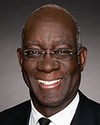Thank you.
Mr. Chair and members, it is my pleasure to be here today to speak about the work our department is doing to support Canada's veterans in securing employment in their post-military life.
On average, 8,500 Canadian Armed Forces members release from service every year. Among this population, approximately 4,000 to 4,500 seek second careers. Statistically, the population of unemployed veterans is comparable to the Canadian average: about 6.6% for Canadians and about 4.5% for veterans. Unfortunately, veterans are more likely to report under-employment and dissatisfaction with not being employed to their full potential.
We know veterans develop many skills throughout their military careers, including leadership, analytical skills, problem-solving and strong communication. We want to support them and provide them with services and tools to realize their career goals. Of course, we know that any workplace transition can be difficult and that veterans can struggle with adapting to the civilian workplace culture.
Veterans Affairs Canada is committed to a whole‑of‑government approach in developing a comprehensive strategy to improve employment opportunities for veterans, promote their well-being, and contribute to their success as they transition to civilian life.
The transition experience is most successful when veterans are able to thrive in various areas of life. Therefore, Veterans Affairs Canada has established a framework for monitoring veteran well-being, which considers seven domains of well-being, including health, life skills, social integration, cultural and social environment, housing and physical environment, and financial security, which is an important goal.
The life after service studies program of research is a partnership between Veterans Affairs Canada and Statistics Canada that began in 2010. The information collected is used to measure the level of well-being among veterans and to inform policies and programs. The program has provided a wealth of information on the health and well-being of veterans and the factors that contribute to adjustment to civilian life. Statistics Canada conducted surveys in 2016 and 2019. The information obtained allows us to better understand veterans' experiences and needs.
The National Census of Canada will also provide Veterans Affairs Canada with valuable information. In 2021, for the first time in 50 years, veterans were identified in the Statistics Canada census. Statistics Canada data released in the fall of 2022 will provide Veterans Affairs Canada with a comprehensive view of the employment situation among the veteran population.
There are many partners involved in supporting veteran employment: stakeholders, employers, advocates, non-governmental organizations, and municipal and provincial governments. The aim of our strategy is to bring many of these components under a unified vision that best serves veterans and their families. We currently support veterans by easing their transition and maximizing opportunities for employment in the public service, private sector or through self-employment.
I'd like to give you some examples of the work that the department has undertaken with respect to supporting veteran employment. Our veterans employment unit is dedicated to supporting veteran employment and career transition. We provide professional career transition support, which includes one-to-one career counselling that helps veterans find work by connecting with potential employers and developing a personalized education or training plan using the education and training benefit.
We are using social media and LinkedIn to connect Canadian veterans with Canadian employers. During the pandemic, we launched a LinkedIn group that, in just over a year, has grown to 3,000 members. About 75% of them are veterans and 25% are employers, recruiters or human resources professionals.
Over the past two years, Veterans Affairs Canada has hosted a series of webinars focused on employment opportunities for veterans and transitioning Canadian Forces members. More than 2,500 people have registered for the series, with an average of 300 people attending each session. More than 100 Canadian employers, including at least a dozen federal departments and agencies, have attended and assisted veterans.
We created a one-stop job bank for veterans—a portal where employers can select candidates—and worked with labour market experts to develop materials to help people.
I would like to stress that Veterans Affairs is involved in supporting many stakeholders that support veteran employment. All of the support gives veterans options.
We'd be happy to take your questions.



